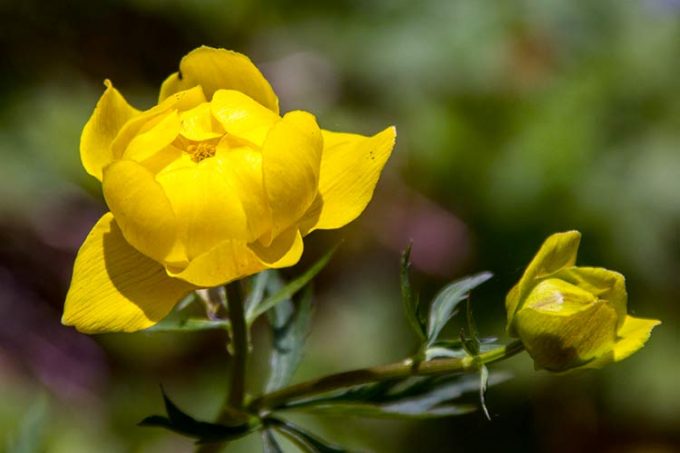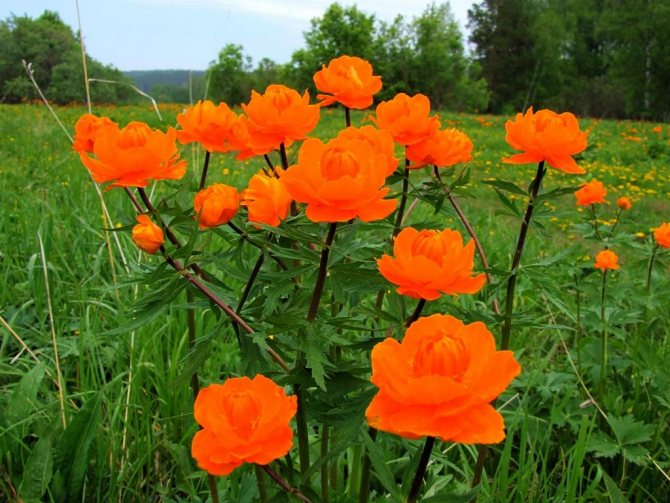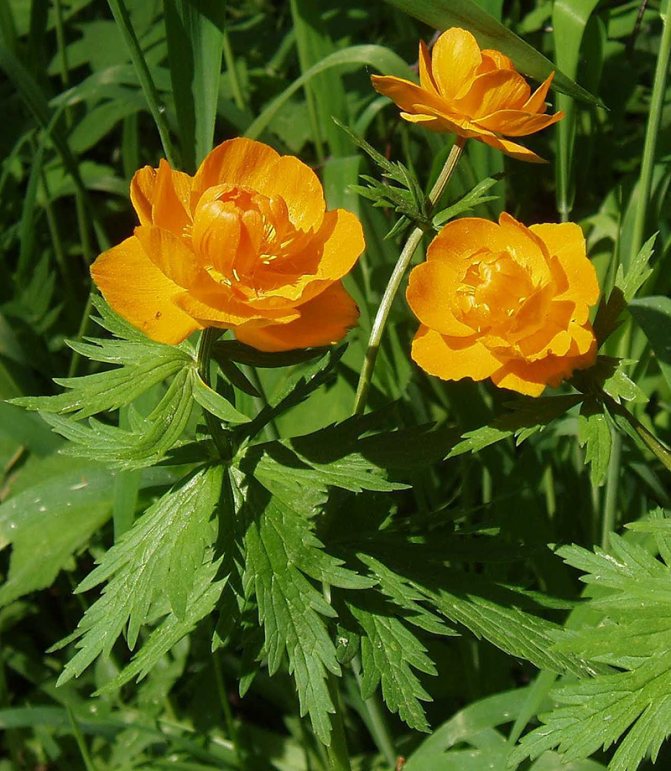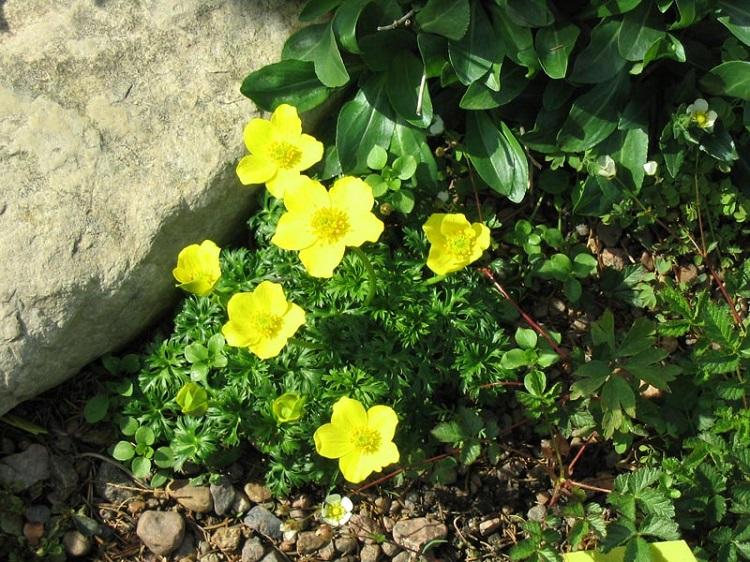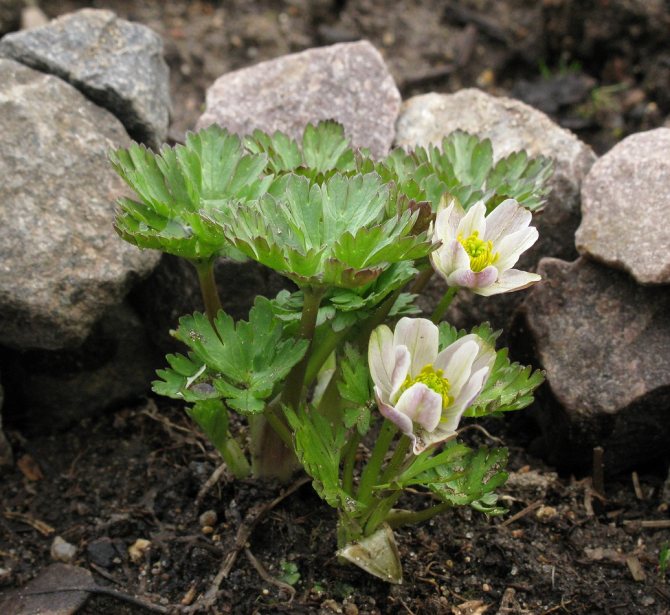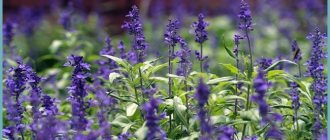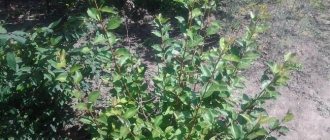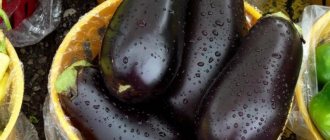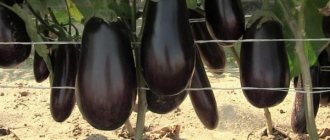The bather is exactly the flower that can easily diversify the entire flower garden, as well as revitalize the local area and add bright and rich colors and a completely nondescript garden plot.
A lush shrub with bright green leaves and orange and yellow flowers creates a great mood in the backyard and gives it a special flavor. This culture is classified as quite unpretentious and its cultivation rarely causes difficulties.
Due to the wide variety of varieties and types of bathers, any gardener can choose a suitable flower for himself, or arrange several and create a group composition of various shrubs.
Bather, a description of the culture
There are several versions of where the name of the plant came from:
- Trollius comes from the German trollblume, literally translated as troll flower. According to ancient legends, the trollius was very fond of these mythical creatures.
- Trulleus in Latin means a rounded vessel, a cup.
- Translated from the Old Germanic troll is a ball.
The Russian name is associated with the habitat of the swimsuit. She prefers wet places.
It is a perennial herb, reaching 0.5-1 m. Stems are erect, in some species they are branched. The root system is well developed. The leaves are dark green, maple-shaped. They grow at the base and on the top of the shoot.
One stem has 1-2 large spherical flowers. The petals are golden yellow, glossy. Corolla of 5-20 sepals arranged in a spiral, overlapping adjacent ones. Semi-open or open buds with thin, linear nectaries.
All varieties are melliferous. Blooms from late spring to autumn. After that (about a month later) the sepals fall off. In their place, a spherical compound fruit begins to form. The seeds are small, dark, with a glossy surface.
When blooming, it exudes a fresh scent The plant is poisonous, its juice can burn the skin or mucous membranes. Actions with the flower must be done with gloves. And also make sure that children and pets do not approach him.
Reproduction methods
Breeding a perennial is possible by dividing the bush and sowing seeds. Any method can be successful. The seeds of the plant will ripen by autumn. You can sow them directly into open ground, but long-term stratification gives the best predictions for high germination. Therefore, sowing has to be done almost in winter. Loose soil with the possibility of air penetration is suitable for this business. The ideal option is as follows: 2 shares of peat, 2 shares of land, 1 share of sand.
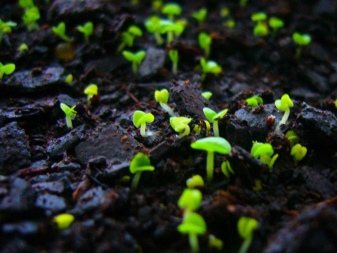
In the first days of May, you can wait for shoots. If at this time the weather is warm in summer, the flowers will need increased watering and shelter from annoying rays. When a couple of full-fledged leaves appear at the seedlings, it's time to dive them. Plant the sprouts 8-10 cm apart. Division of the bush:
- In the fall, the trollius needs to be dug up, divided into parts, delenki (each - with shoots and rhizomes).
- Each piece is planted in a place prepared in advance. Before frost, the bushes should root well. If you decide to start dividing a perennial in the spring, do it before the flowering stage.
- The material prepared for planting should not dry out.You need to plant delenki quickly. Embed the root collar by 2 cm.
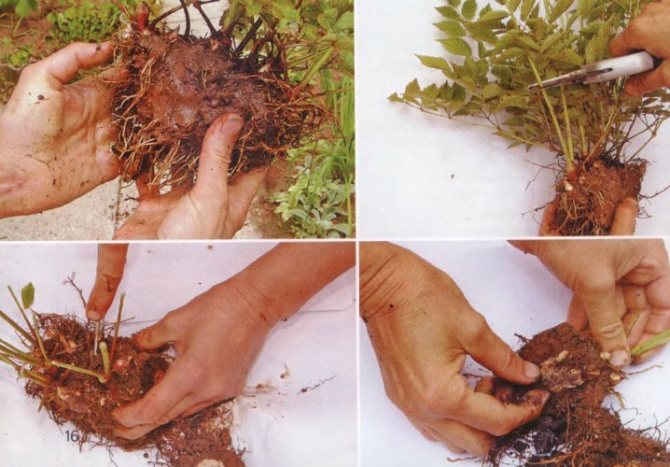

Array
Types and varieties
There is a choice, and it attracts with its diversity. The name "Cultural" combines a series of garden forms and perennial species. Of course, varietal representatives have larger and brighter flowers.
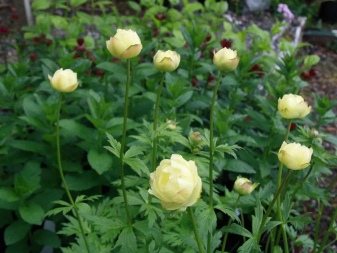

The most famous species of trollius is European. It is characterized by double, spherical, pale lemon flowers. Another name for the species is gourd. The Asian variety, which is a perennial with juicy orange single flowers, has also become widespread. The Chinese trollius has expressive orange flowers and is distinguished by its late flowering appearance. Today this plant is listed in the Red Book, it is threatened with extinction.
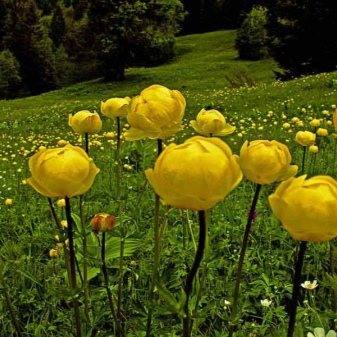

"Ledebour" is similar to it, but its flowers are larger. A dwarf swimsuit, which resembles a large buttercup, stands apart in this row. In Central Asia and certain regions of Western Siberia, the Altai bathing suit grows. This is one of the most spectacular perennial species.


And it is quite unusual against the background of the listed species that a purple swimsuit looks. Faded lilac flowers with yellow stamens seem delicate and defenseless. Such a plant would decorate any garden, but unlike its congeners, it is very demanding on growing conditions. It grows in a swampy environment, in places where glaciers are melting.
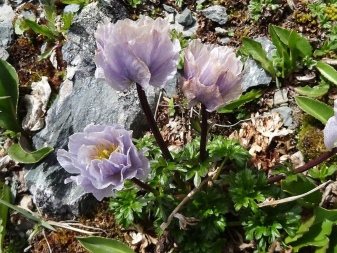

The following varieties are considered especially popular with gardeners:
Cheddar ("Cheddar") - soft cream flowers and soft lemon stamens, a very graceful variety;
Swimsuit outdoor landing
If the plant is grown from seed, they first need to undergo stratification:
- Sow in autumn.
- Transfer to a cool room and leave until spring.
- In late March and early April, the first shoots can be observed.
There is one more way to stratify:
- Mix the freshly harvested seeds with wet sand.
- Pour the mixture into a plastic bag.
- Place in the refrigerator in the vegetable compartment (+ 2 ... + 4 ° С).
- Hold for 3-4 months.
- Sow in March.
- Keep at +20 ° C.
- Shoots will sprout in late April to mid-May.
Seedling care before planting in open ground:
- Protect from direct sunlight, regularly moisten the soil mixture.
- Transplant after the formation of 2 true leaves.
- When diving, leave 0.8-1 cm.
Landing in a permanent place is performed in August:
- Dig up holes at a distance of 30-40 cm, corresponding to the size of the roots.
- Move the shoots along with the earthy clod.
- Flowering can be observed for 3-4 years.


Caring for a swimsuit in the garden
In order for the plant to develop well, retain its decorative effect, it is necessary to create favorable conditions for it:
| Factor | Recommendations |
| Location | Areas with diffused sunlight. For example, next to spreading bushes, trees. |
| The soil | Light, nutritious soil: medium or light loamy, with a lot of humus, neutral acidity. If the land is poor, peat and humus are introduced in equal proportions. This helps absorb and retain moisture. For 1 sq.m. you need 5 kg of the mixture. |
| Top dressing | Fertilizers are used in small dosages:
Do in early May and before flowering. |
| Watering | During the growing season, the soil should always be moist, but at the same time it is necessary to ensure that no stagnation of liquid occurs. With a lack or excess of moisture, the plant will stop blooming and growing. Pour with settled water heated in the sun. In the morning, a bucket of liquid is placed on the site, and in the evening they are watered. |
| Wintering | A distinctive feature of the plant is frost resistance. It calmly endures the cold. Before winter rest, the aboveground part is cut off, leaving only 3 cm. |
| Another care | The top layer of the earth is periodically renewed, adding fertile soil to the base. After the petals fall off, the peduncles are cut to re-emerge the buds. |
Reproduction and transplantation
Growing from seeds is a long and complicated process, and gardeners rarely use it. The preferred way of dividing the curtain.
Healthy, strong plants, 5-6 years old, are suitable for reproduction.
A transplant is done every 5 years, in late August and early September. Phased process:
- Gently remove the mother bush, clean it from the ground, rinse.
- Divide into parts with a disinfected sharpened knife so that several rosette stems with roots remain on the divide.
- Treat the cut sites with a solution of potassium permanganate or wood ash.
- Place the petioles in the planting holes located at a distance of 0.3-0.4 m from each other.
- The root collar is buried by 20-30 mm.
- Remove the greens from the cut. Young foliage can be observed in 10-14 days.
Growing conditions in the garden
What places like bushes with flowers in shades of sunlight? What kind of conditions do they like? They don't need anything special. In nature, flowers choose the optimal places for growth, but at their summer cottage, a person can provide ideal care and create comfort for a perennial.
Indoor spurge: varieties, features of home care
All that a swimsuit plant needs:


a sufficient amount of moisture (the more sun there is on the site, the more moisture it needs);- sunny place in the garden;
- optimal soil - loam, rich in organic matter;
- the acidity level of the soil should be close to neutral;
- the ideal soil mixture is leaf soil, peat and sand in a ratio of 1: 1: 0.5;
- if you add chopped sphagnum moss, moisture will stay in the soil or substrate longer;
- despite the hygrophilousness of the swimsuit, stagnation of water in the flower bed is undesirable.
Under conditions of waterlogging, the growth rate of the plant decreases.
Prevention and control of swimwear pests, diseases
The swimsuit practically does not get sick, insects rarely live on it. To reduce the likelihood of damage to a minimum, in the spring they are treated with ash, watered with nitrogen-containing fertilizers. In the future, they switch to complex mixtures. It is recommended to spray with Epin before vegetation. In order to prevent fungal infections in the fall, you need to remove old leaves.
Rarely, in the absence of care, a swimsuit can get sick:
| Disease / pest | Signs | Control measures |
| Septoria |
|
|
| Smut |
| Use the preparations Klad, Ferazim. |
| Nematodes |
| Apply poisons Phosphamide, Heterophos, Lindane. |
Possible problems when caring for a swimsuit and their solutions


The Siberian rose can please its owners with the fact that it almost never suffers from diseases and does not particularly suffer from pests. Perhaps the last aspect is the poisonous sap of the plant. To prevent diseases caused by fungi, it is recommended to remove all dead foliage in the fall.
It happens that a swimsuit occasionally becomes a victim of the following diseases: smut, septoria, penetrating short-bodied nematode. It is usually recommended to treat planting diseases with fungicidal preparations, for example, TMTD, Fundazol, and apply insecticides from the last pest - Tanrek and herbicides, such as Tornado.
- See Disease and Pest Control Methods for Liver Woman Care
The place of the swimsuit in landscape design
Low-growing varieties are suitable for decorating rocky hills. Long-growing varieties decorate the edges, corners of lawns, areas near water bodies.
The swimsuit is planted alone or in combination with:
- delphinium;
- primrose;
- cornflowers;
- irises and other garden flowers of heavenly, purple, canary, orange tones.
The plant looks beautiful in a variegated composition: a dwarf swimsuit in the foreground, behind tall bushes blooming at the same time as the trollius (for example, lilac).
Popular views with photos
In nature, there are 29 varieties of herbaceous perennial. 20 of them grow on the territory of Russia. Kupavka is mainly found in Siberia and the Far East. Cultivated species and varieties can be grown in all regions of our country.
European
European swimsuit grows massively on the territory of the Russian Federation. What does a plant look like?
So, the European kupavka belongs to the decorative types. The average height of a herbaceous perennial is 70–80 cm. Long-petiolate leaf plates have 3 to 5 lobes. The leaf width reaches 3 cm. The perennial flowering period occurs at the end of May. The European variety is characterized by large spherical buds of a golden yellow or lemon yellow color.
Asian
The Asian bather, or Siberian hot, grows mainly in Asia. The main difference between the Asian variety is the bright orange color of the buds. Most varieties are characterized by semi-double and double flower shapes.
Altai
The Altai variety is very similar to the Asian one. Distinctive features are the wavy edges of the petals and black blotches inside the orange buds. The flowering period falls in the first month of summer.
Chinese
The Chinese bather belongs to the tall species. Peduncle height reaches 80 cm. Buds are bright orange in color. Elongated nectary petals are located in the center of the flower. The perennial blooms closer to the middle of summer.
Ledebour
Ledebour's bather has similarities with the Chinese variety. The bright orange flowers are complemented by tall nectary petals. The bud reaches 8 cm in diameter. The flowering period begins at the end of June and lasts until mid-July. The average height of the herbaceous shrub is 70 cm.
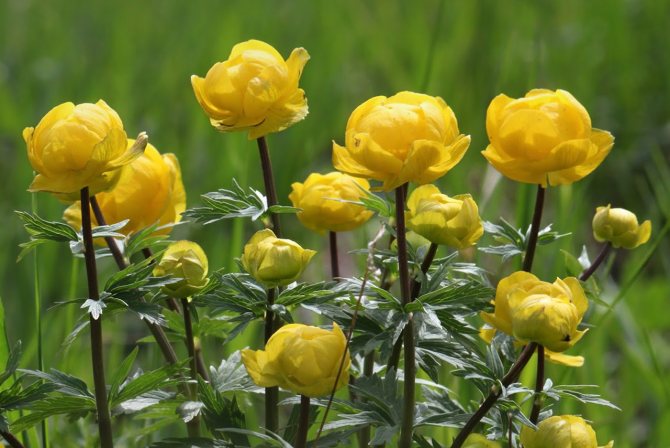

European


Asian
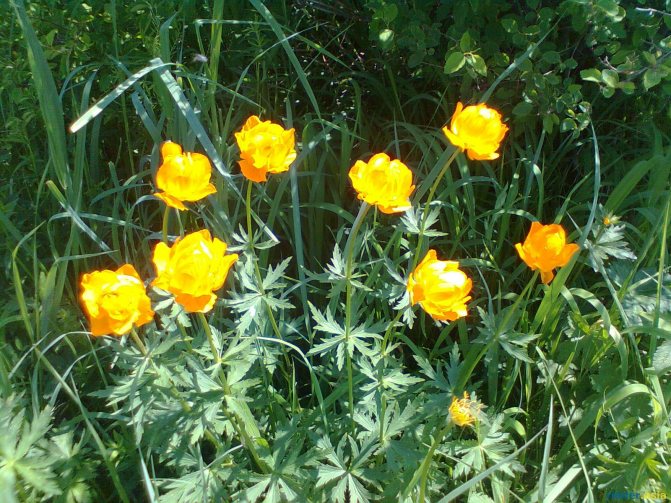

Altai


Chinese


Ledebour
The most beautiful and, accordingly, popular varieties in Russian gardening are:
- Orange Princesses;
- Cheddar;
- Goliath;
- Orange King;
- Lightball;
- Lemon Quinn et al.
The use of a swimsuit in traditional medicine
Despite the fact that the flower is poisonous, it has medicinal properties. In folk medicine, it is used to treat many diseases:
- pathological conditions of the liver and gastrointestinal tract;
- abscesses, swelling, swelling;
- diarrhea;
- dropsy;
- scabies;
- epileptic seizures;
- problems with menstruation;
- angina pectoris and other heart diseases;
- cancer and precancerous conditions;
- blood diseases.


Folk remedies from a flower have contraindications and adverse reactions. Talk to your doctor before using them. If he approves of an unconventional treatment, the recipe must be strictly followed to avoid poisoning. The venom of a swimsuit can cause serious brain problems, severe burns, and severe intoxication.
Facts to note about the swimsuit flower
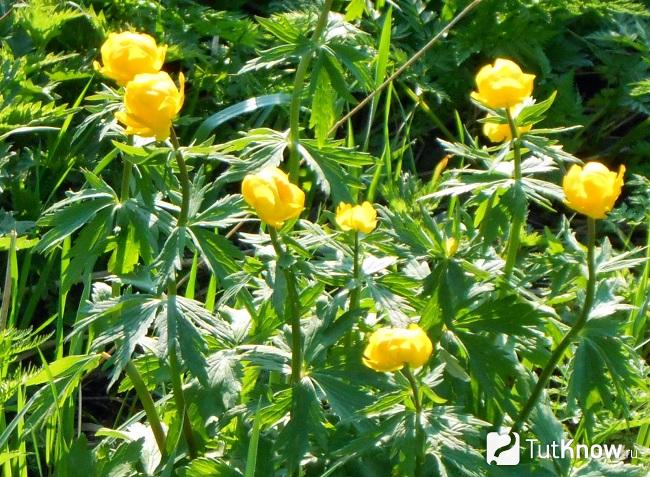

Certain types of Siberian rose have long been used in oriental medicine, while only flowers and leaf plates are used. For medicinal purposes, root processes are almost never used.
Important!!!
The roots of the swimsuit are very poisonous, after any work with them it is recommended to wash your hands thoroughly or use gloves.When planting in the garden, it is worth choosing a place for frying, where children will not have access, since the juice from its plucked flowers or leaves is very poisonous. After any contact with the plant, be sure to wash your hands with soap and water. It is dangerous to get the juice in the eyes.
Preparations made on the basis of the aerial part of the lights can have a strong choleretic effect on the human body, while the tone of both the gallbladder and the smooth muscles of the intestine decreases. Such medicines are prescribed to relieve swelling and as a diuretic. Siberian rose ointment was used to treat skin diseases such as scabies, various inflammations or abscesses, and was also used for epilepsy.
Attention!!!
Any use of swimsuit-based potions should be carried out strictly under the supervision of a physician, since the plant is poisonous. Therefore, it is used very rarely.
All types of frying are excellent melliferous plants, and the grass goes well for livestock feed.
- See also curious notes about the peony flower


